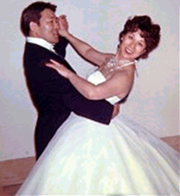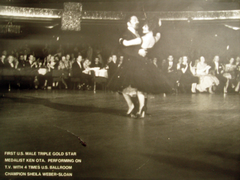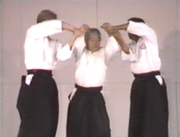
Ken and Miye Ota
Encyclopedia

Goleta, California
Goleta is a city in southern Santa Barbara County, California, USA. It was incorporated as a city in 2002, after a long period as the largest unincorporated, populated area in the county. As of the 2000 census, the Census-designated place had a total population of 55,204, however, a significant...
.
Ken Ota
Kenji Ota (born May 14, 1923) is a second generation Japanese-American, also known as NiseiNisei
During the early years of World War II, Japanese Americans were forcibly relocated from their homes in the Pacific coast states because military leaders and public opinion combined to fan unproven fears of sabotage...
, raised in Lompoc, California
Lompoc, California
Lompoc is a city in Santa Barbara County, California, United States. The city was incorporated in 1888. The population was 42,434 at the 2010 census, up from 41,103 at the 2000 census....
. He and his family were placed in the Japanese internment camps
Japanese American internment
Japanese-American internment was the relocation and internment by the United States government in 1942 of approximately 110,000 Japanese Americans and Japanese who lived along the Pacific coast of the United States to camps called "War Relocation Camps," in the wake of Imperial Japan's attack on...
of World War II. There, he met and married his wife, Miye Ota.
In 1948, after his release from the internment camp, Ota settled in Goleta, California, and with his family’s help, built a home from bricks on the converted swamplands.
Miye Ota
Miye Tachihara Ota (born in 1918), was raised in Guadalupe, CaliforniaGuadalupe, California
Guadalupe is a small city located in Santa Barbara County, California. According to the U.S. Census of 2010, the city has a population of 7,080. It was incorporated as a city on May 19, 1946...
. Like Ken, she is also Nisei and she and her family were placed in the Japanese internment camps of World War II, where she met her future husband at the Gila River Relocation Center.
Following her release from internment camp and a brief stay in Philadelphia, PA, Miye went to beauty school and opened her own salon, which the Otas built themselves from bricks attached to their home in Goleta.
Ballroom Dance

Alex Moore certified both Ken and Miye in the International Style of ballroom dance. Ken went on to be the first man in the U.S. to get the highest Arthur Murray student credentials, Triple Gold Star and Gold Bar. The Otas were also certified through the Imperial Society of Teachers of Dancing (ISTD).
Ken’s most notable instructor was Sheila Webber-Sloan, a national ballroom dance champion
U.S. National Dancesport Champions (Professional Standard)
The United States national professional ballroom dance champions are crowned at the United States Dance Championships , as recognized by the National Dance Council of America and the World Dance & DanceSport Council ....
; the Webber-Sloan and Ota partnership garnered multiple awards and had several appearances on television, including a broadcast of the California Star Ball.
It was not until chaperoning a school dance for their son, Steve Ota, did they feel compelled to start teaching dance lessons to children; they believed children could learn more tasteful ways of dancing with each other. Having achieved their competitive goals, they founded a junior cotillion
Cotillion
In American usage, a cotillion is a formal ball and social gathering, often the venue for presenting débutantes during the débutante season – usually May through December. Cotillions are also used as classes to teach social etiquette, respect and common morals for the younger ages with the...
, where they could teach their son and his friends lessons in dance, manners, and other social graces. The Otas were also contracted to teach these classes by several schools and organizations over the years, including the Junior League of Santa Barbara.
The popularity of their classes grew such that they built their own “cultural school” adjacent to their Goleta home. The school’s brick structure houses a spacious hardwood floor surrounded by white benches and mirrors, and a ceiling that adorns two crystal chandeliers.
Ken Ota still teaches ballroom dancing for UC Santa Barbara as a class for physical education credit, along with separate sessions open to the community through the university’s leisure arts program. His class has also spawned several student-run social clubs that revolve around swing dancing
Swing (dance)
"Swing dance" is a group of dances that developed with the swing style of jazz music in the 1920s-1950s, although the earliest of these dances predate swing jazz music. The best known of these dances is the Lindy Hop, a popular partner dance that originated in Harlem and is still danced today...
, ballroom, and competitive ballroom dancing
DanceSport
Dancesport denotes competitive ballroom dancing, as contrasted to social or exhibition dancing. It is wheelchair dancesport where at least one of the dancers is in a wheelchair....
.
Martial Arts

Sumo
is a competitive full-contact sport where a wrestler attempts to force another wrestler out of a circular ring or to touch the ground with anything other than the soles of the feet. The sport originated in Japan, the only country where it is practiced professionally...
and Judo
Judo
is a modern martial art and combat sport created in Japan in 1882 by Jigoro Kano. Its most prominent feature is its competitive element, where the object is to either throw or takedown one's opponent to the ground, immobilize or otherwise subdue one's opponent with a grappling maneuver, or force an...
, which he regularly participated in from the time he had been placed in the Japanese internment camps of World War II. It was not until 1963 during his regular commutes to Los Angeles for dance lessons did he come across the art of Aikido
Aikido
is a Japanese martial art developed by Morihei Ueshiba as a synthesis of his martial studies, philosophy, and religious beliefs. Aikido is often translated as "the Way of unifying life energy" or as "the Way of harmonious spirit." Ueshiba's goal was to create an art that practitioners could use to...
. The whole Ota family enrolled in classes under Isao Takahashi. The Otas then moved onto training in Shin Shin Toitsu Aikido under Koichi Tohei
Koichi Tohei
was a 10th Dan aikidoka and founder of the Ki Society and its style of aikido, officially Shin Shin Toitsu Aikido , but commonly known as Ki-Aikido.-Koichi Tohei and aikido:...
.
The Otas built their own “cultural school” next to their Goleta home, which could easily transform into a dojo
Dojo
A is a Japanese term which literally means "place of the way". Initially, dōjōs were adjunct to temples. The term can refer to a formal training place for any of the Japanese do arts but typically it is considered the formal gathering place for students of any Japanese martial arts style to...
when fitted with removable tatame mats; the main wall adorns a traditional Japanese shomen, which includes photos of Morihei Ueshiba
Morihei Ueshiba
was a famous martial artist and founder of the Japanese martial art of aikido. He is often referred to as "the founder" or , "Great Teacher".-Early years:Morihei Ueshiba was born in Tanabe, Wakayama Prefecture, Japan on December 14, 1883....
, Koichi Tohei, and a large symbol painted by Tohei himself.
The Otas offered classes to children and adults in Judo and Aikido, and also consulted local law enforcement. Ken was hired to teach martial arts at UC Santa Barbara and Cal Poly San Luis Obispo, where he became advisor for several clubs, including a women’s Judo team. Ken was also contracted by Panther Productions to produce a series of Aikido instructional videos.
Ken and Miye’s son, Steve, returned to Santa Barbara after completing his studies at San Jose State University
San José State University
San Jose State University is a public university located in San Jose, California, United States...
, where he was a member of the championship Judo team. In the years since Steve’s return, many of the adult and high-level classes have transitioned to Steve’s direction, as he continues to train and receive recognized ranks in KI Aikido, along with teaching Aikido at UCSB.
External links
Video: Master Ken Ota Aikido - source: youtube.comWeb site detailing Ken Ota's Aikido teaching methods, especially his remarkable children's methods:
http://home.comcast.net/~j.sing/Ota_Aikido/

